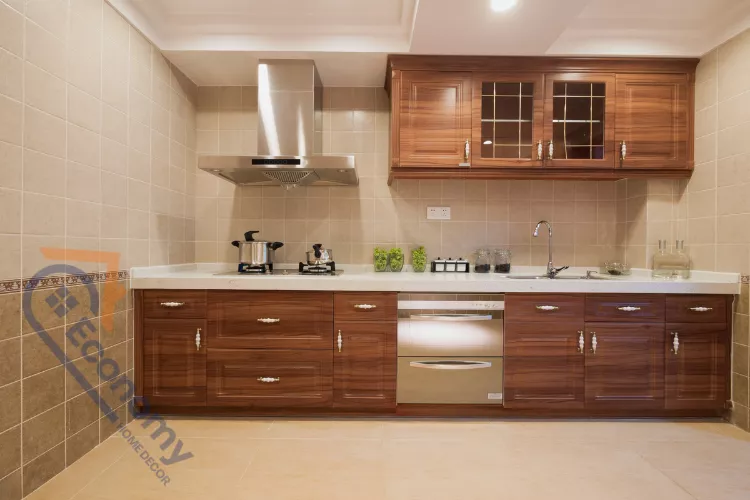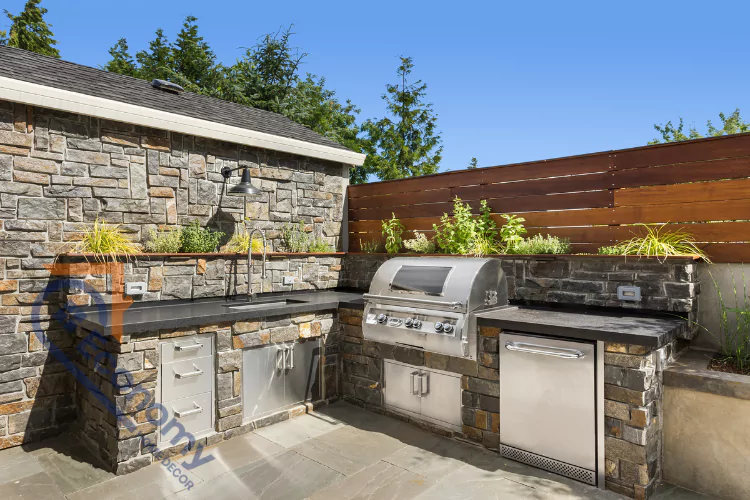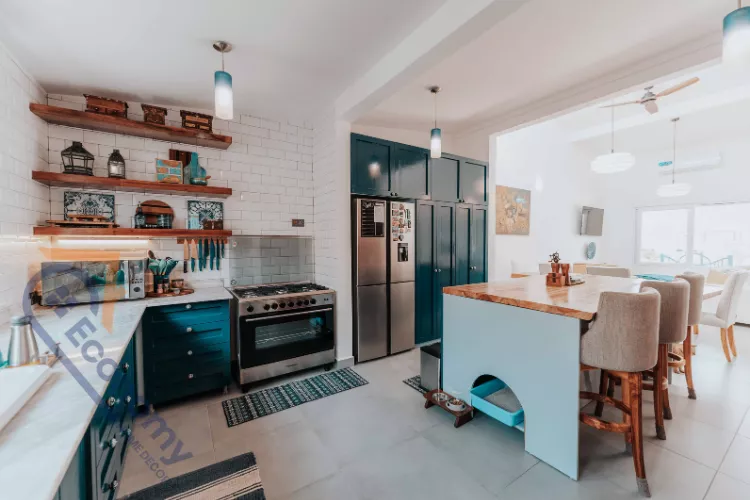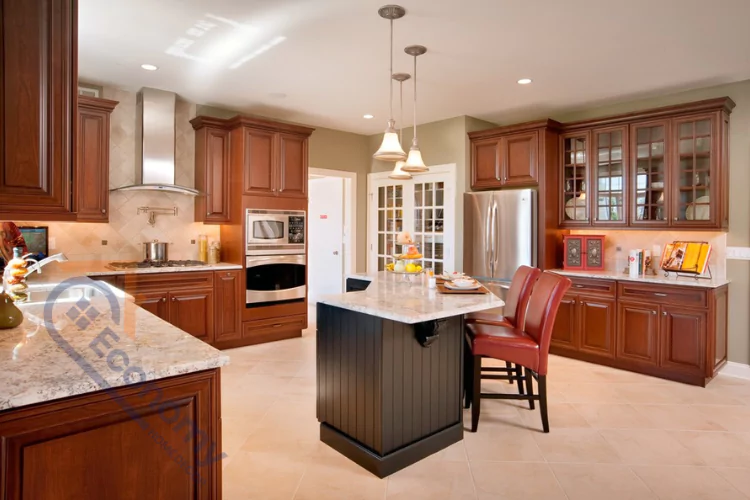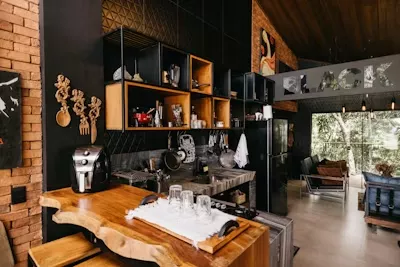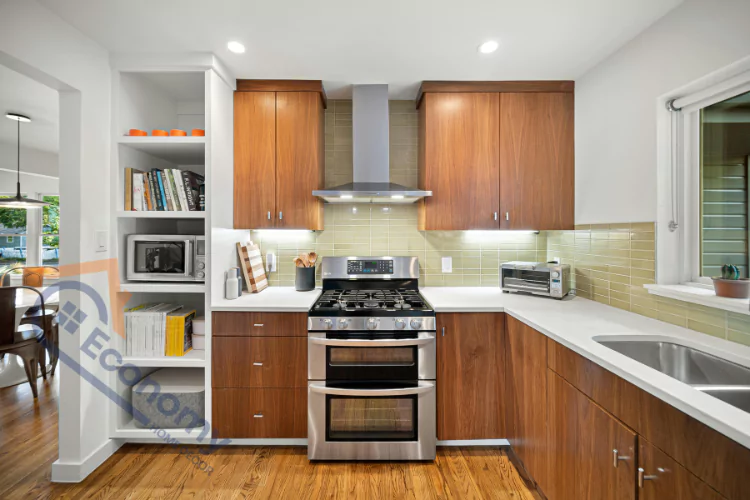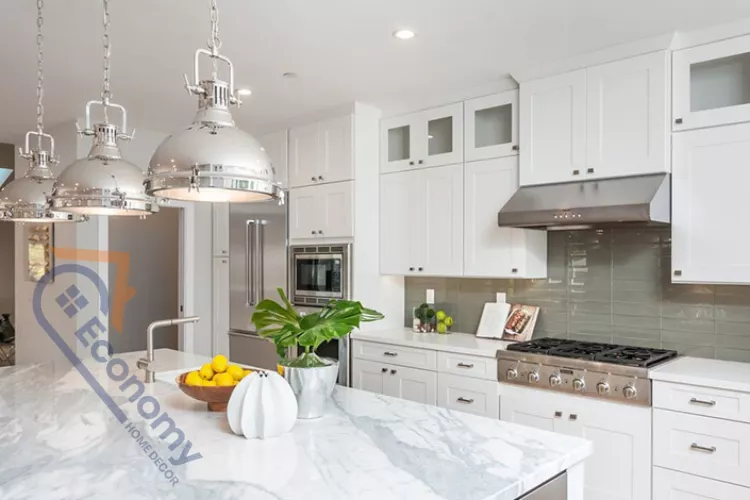Have you ever walked into a kitchen and felt instantly transported to a simpler, more elegant time? That’s the magic of colonial kitchen decorating ideas. These classic designs bring warmth, history, and undeniable charm to the heart of your home. Whether you’re drawn to the refined elegance of British colonial style or the rustic warmth of early American design, colonial kitchens offer a timeless appeal that never goes out of fashion.
Colonial decorating ideas kitchen rooms blend functionality with beauty, creating spaces that are both practical for modern living and rich with historical character. From exposed wooden beams to farmhouse sinks, these design elements have stood the test of time for good reason. They create kitchens that feel inviting, lived-in, and full of personality. In this guide, we’ll explore fifteen inspiring ways to bring colonial charm into your kitchen, transforming it into a space that honors the past while serving your present-day needs.
Key Takeaways
- Colonial kitchen decor emphasizes natural materials, craftsmanship, and timeless elegance
- Wood cabinetry, often in cherry, maple, or pine, forms the foundation of colonial kitchen decorating
- Open shelving and glass-front cabinets showcase beautiful dishware and add authentic period charm
- Farmhouse sinks, brass fixtures, and butcher block countertops are signature colonial elements
- Color palettes feature warm neutrals, deep blues, greens, and classic cream tones
- Authentic details like wrought iron hardware and exposed beams complete the colonial look
1. Classic Wood Cabinetry as Your Foundation
When it comes to colonial kitchen decorating, nothing sets the tone quite like beautiful wood cabinetry. Colonial kitchens traditionally featured handcrafted wooden cabinets made from local hardwoods like cherry, maple, oak, or pine. These materials weren’t just chosen for their beauty—they were practical, durable, and readily available to colonial craftsmen.
For an authentic colonial kitchen decor approach, consider cabinets with raised panel doors and simple, clean lines. The beauty lies in the natural wood grain rather than ornate carvings or modern embellishments. You might choose a rich cherry finish for a more formal British colonial kitchen decor feel, or opt for painted cabinets in classic cream, soft gray, or colonial blue for a lighter, more casual atmosphere.
The hardware on your cabinets matters tremendously in achieving an authentic look. Choose brass, bronze, or wrought iron pulls and hinges that reflect the period. Simple round knobs or cup pulls work beautifully and stay true to the colonial aesthetic. Remember, colonial craftsmen valued function as much as form, so your cabinets should offer plenty of storage while maintaining their classic appeal.
Don’t feel obligated to make every cabinet door solid, either. Glass-front upper cabinets were common in colonial homes, allowing homeowners to display their finest china and serving pieces. This practical design element also makes your kitchen feel more open and spacious while adding visual interest to your walls.
2. Embrace Open Shelving for Display and Function
Open shelving is one of the most authentic colonial decorating ideas kitchen rooms can incorporate. In colonial times, closed cabinetry was expensive and not always practical, so many kitchens featured open shelves where everyday dishes, cookware, and provisions were stored within easy reach. This design choice wasn’t just about necessity—it created an inviting, lived-in feeling that modern homeowners love.
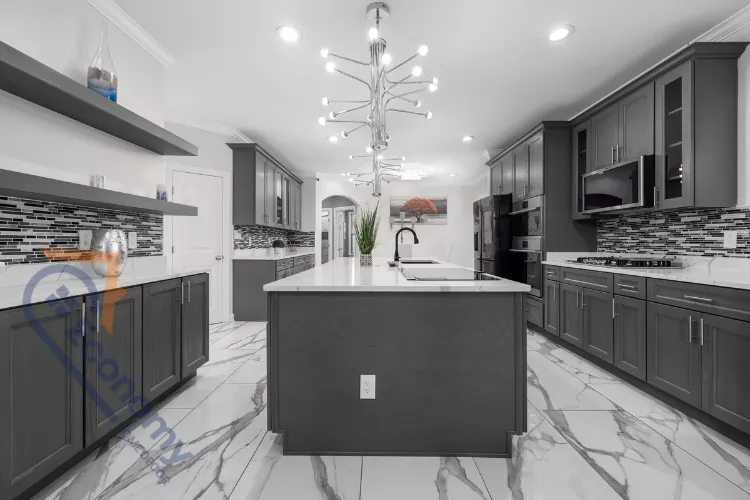
Installing open shelving in your kitchen serves multiple purposes. First, it provides an opportunity to display beautiful dishware, vintage copper pots, and earthenware that reinforces your colonial theme. Second, it keeps frequently used items accessible, making your kitchen more functional. Third, it breaks up the visual weight of wall cabinets, creating a more relaxed and welcoming atmosphere.
For the most authentic look, choose thick wooden shelves with visible brackets made from wrought iron or wood. Pine shelving with a natural finish captures the colonial spirit beautifully, though painted shelves in cream or white can work equally well. Style your shelves thoughtfully with a mix of practical items and decorative pieces—stacked ironstone plates, vintage glass jars filled with dry goods, wooden cutting boards, and perhaps a few antique kitchen tools.
Keep in mind that open shelving requires some maintenance and organization. You’ll want to keep displayed items clean and arrange them in a visually pleasing way. However, this small effort pays off in creating a kitchen that feels warm, personal, and authentically colonial in character.
3. Install a Deep Farmhouse Sink
Few elements say “colonial kitchen” quite like a deep, apron-front farmhouse sink. These generous basins were standard in colonial homes because they could accommodate large pots, serve as washtubs, and handle the considerable demands of colonial-era cooking and cleaning. Today, they remain one of the most sought-after features in colonial kitchen decorating.
A traditional farmhouse sink features an exposed front panel that extends past the edge of your countertops, creating a distinctive and practical design. Originally made from materials like soapstone, copper, or fireclay, these sinks came in neutral colors that complemented the natural materials used throughout colonial kitchens. For an authentic colonial kitchen decor look, consider a white fireclay sink or a stunning copper option that develops a beautiful patina over time.
The deep basin of a farmhouse sink offers modern advantages too. You can easily wash large cookware, fill tall vases, and even bathe small children or pets. The front-facing design also reduces strain on your back since you can stand closer to the sink without the cabinet face getting in your way. This combination of historical authenticity and practical function makes farmhouse sinks perfect for today’s colonial-inspired kitchens.
Pair your farmhouse sink with a bridge-style faucet in oil-rubbed bronze, unlacquered brass, or polished nickel. These fixtures complement the colonial aesthetic while providing the performance you need. Some homeowners also add a vintage-style sprayer or a soap dispenser in matching finishes to complete the look.
4. Choose Warm, Natural Color Palettes
Color plays a crucial role in establishing authentic colonial decorating ideas kitchen rooms should embody. Colonial homes featured colors derived from natural pigments and materials available during that era. Think warm creams, soft grays, deep colonial blues, forest greens, brick reds, and rich golden yellows. These colors create a welcoming, comfortable atmosphere that defines colonial style.
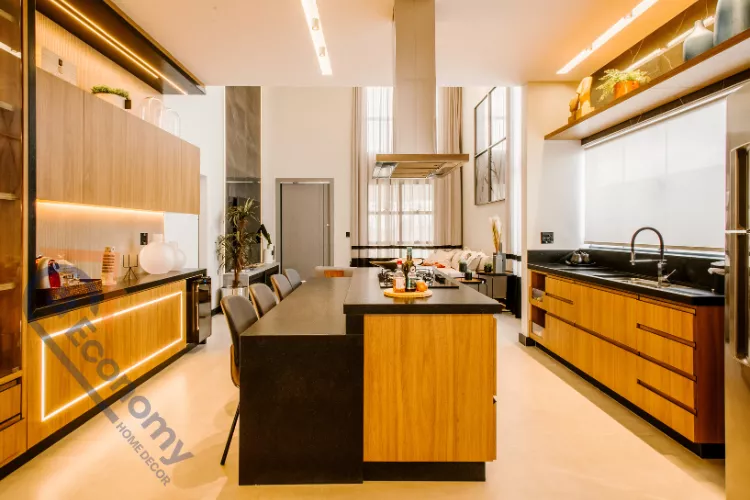
For your walls, consider warm white, cream, or soft butter yellow as a base. These light, neutral tones reflect the whitewash and milk paint commonly used in colonial homes. They also provide a perfect backdrop for darker wood cabinetry and furniture. If you want more color, colonial blue—a deep, slightly grayish blue—works beautifully as an accent wall or cabinet color and was extremely popular in early American homes.
Your cabinetry offers another opportunity to incorporate period-appropriate colors. While natural wood finishes are always appropriate, painted cabinets in colors like sage green, slate gray, or colonial blue can add depth and interest to your space. Consider painting lower cabinets one color and upper cabinets or open shelving another for a subtle two-tone effect that adds visual dimension.
Don’t forget about ceiling colors, either. Many colonial kitchens featured painted ceilings in colors like sky blue, which was believed to repel insects. Whether you embrace this tradition or stick with white, consider adding exposed wooden beams in a darker stain to create architectural interest and authentic colonial character overhead.
Colonial Kitchen Style Comparison Table
| Style | Key Colors | Signature Materials | Best For |
|---|---|---|---|
| British Colonial Kitchen Decor | Deep mahogany, cream, sage green | Dark hardwoods, brass fixtures, marble | Formal, elegant spaces with refined details |
| Early American Colonial | Warm whites, brick red, colonial blue | Pine, maple, pewter, copper | Rustic, welcoming family kitchens |
| Spanish Colonial Kitchen Decor | Terracotta, warm yellows, turquoise | Clay tiles, wrought iron, stucco | Bright, textured spaces with handcrafted appeal |
| Virginia Colonial Kitchen Decor | Williamsburg blue, cream, burgundy | Cherry wood, brass, limestone | Traditional spaces with historical accuracy |
5. Add Butcher Block Countertops for Authenticity
Countertops in colonial kitchens were typically made from natural materials that could withstand heavy use. Butcher block countertops offer one of the most authentic and practical options for colonial kitchen decorating. These solid wood surfaces were essential work areas in colonial homes, providing a durable space for food preparation, and they bring that same functionality and warmth to modern kitchens.
Butcher block is typically made from hardwoods like maple, oak, walnut, or cherry, arranged in strips and bonded together. The natural wood grain adds warmth and texture to your kitchen while creating a perfect work surface for chopping, rolling dough, and other food preparation tasks. Over time, butcher block develops a rich patina that tells the story of your kitchen’s use, adding to its character and charm.
For the most authentic colonial look, consider using butcher block as your primary countertop material throughout the kitchen. However, if you’re concerned about maintenance or prefer stone for certain areas, you can also use butcher block on an island while choosing soapstone, marble, or granite for perimeter counters. This mixed approach was actually quite common in colonial homes, where different work surfaces served different purposes.
Maintain your butcher block by regularly oiling it with food-safe mineral oil or a specialized butcher block conditioner. This simple care routine keeps the wood nourished, prevents cracking, and maintains the beautiful appearance. While butcher block requires more attention than stone countertops, many homeowners find this hands-on maintenance connects them to the colonial tradition of caring for handcrafted materials.
6. Incorporate Wrought Iron and Period Hardware
The details make all the difference when creating authentic colonial kitchen decor, and hardware is where these details really shine. Colonial craftsmen worked primarily with iron, brass, copper, and pewter, creating functional pieces that were also beautifully simple in design. Incorporating period-appropriate hardware throughout your kitchen instantly elevates the colonial atmosphere.
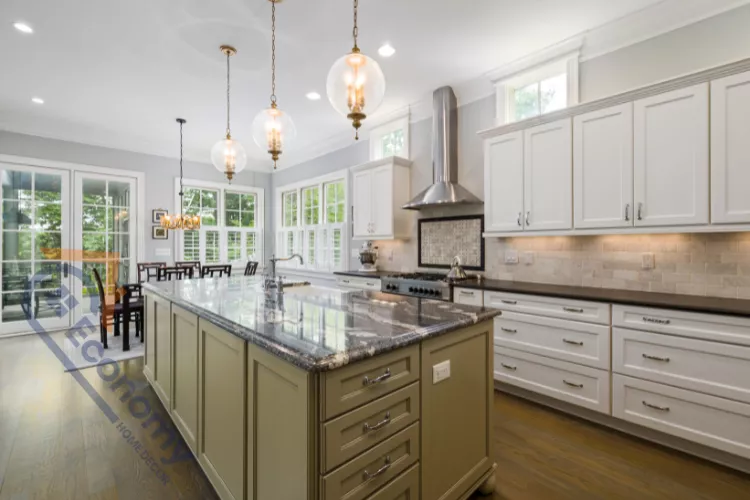
Wrought iron was especially important in colonial kitchens. Blacksmiths created everything from pot racks and hooks to hinges and latches from this durable material. Today, you can find reproduction wrought iron hardware that captures this handcrafted quality. Look for cabinet pulls with a hand-forged appearance, strap hinges for doors, and iron hooks for hanging pots, utensils, and towels.
Brass hardware offers another authentic option, particularly for British colonial kitchen decor styles. Brass knobs, pulls, and bin pulls bring a touch of refinement while maintaining historical accuracy. Choose unlacquered brass that will develop a natural patina over time, or opt for polished brass if you prefer a brighter, more maintained look. Both finishes were common in colonial homes and remain appropriate today.
Don’t limit yourself to just cabinet hardware. Consider adding wrought iron brackets for open shelving, a vintage-style brass faucet, iron curtain rods, and even decorative iron pieces like trivets or wall-mounted pot racks. These thoughtful touches create layers of authenticity that transform a simple kitchen into a space that truly embodies the colonial spirit.
7. Install Wide-Plank Hardwood Flooring
Flooring sets the literal foundation for your colonial decorating ideas kitchen rooms can build upon. Colonial homes almost exclusively featured wide-plank hardwood floors made from whatever timber was locally available—typically pine, oak, or chestnut. These floors were practical, durable, and could be sanded and refinished as needed, often lasting for generations.
Wide-plank flooring (typically five inches or wider) immediately signals colonial authenticity. The wider planks were common because they could be cut from the large-diameter trees that were abundant during colonial times. Today, reclaimed wide-plank flooring offers the most authentic look, complete with saw marks, nail holes, and other character marks that tell a story. If reclaimed wood isn’t in your budget, new wide-plank flooring in species like white oak or pine can still capture the colonial feel.
For the most authentic appearance, choose flooring with a matte or low-sheen finish rather than high-gloss polyurethane. Colonial floors were often left bare or treated with simple oils and waxes, creating a more natural, less reflective surface. Many homeowners today choose oil-based finishes or hard wax oil products that protect the wood while maintaining this authentic appearance.
Consider the color carefully as well. Light to medium wood tones in natural or honey finishes reflect the aged appearance of original colonial floors. If you prefer darker floors, be aware that very dark stains are more Victorian than colonial. Whatever finish you choose, wide-plank hardwood floors add warmth underfoot and create a perfect backdrop for your colonial kitchen’s other design elements.
8. Display Copper and Pewter Cookware
Colonial kitchens were full of beautiful, functional objects, and displaying these items was both practical and decorative. Copper pots and pewter serving pieces were prized possessions in colonial homes—expensive investments that families cared for and passed down through generations. Incorporating these metals into your colonial kitchen decorating creates instant authenticity and visual warmth.
Copper cookware wasn’t just beautiful; it was the best cooking technology available during colonial times. Copper conducts heat evenly and responds quickly to temperature changes, making it ideal for cooking. Today, displaying copper pots on open shelving, hanging them from a pot rack, or arranging them on your stovetop adds gorgeous warm metallic tones to your kitchen while honoring colonial tradition.
Pewter, an alloy of tin with copper and antimony, was used for plates, tankards, candlesticks, and serving pieces in colonial homes. Its soft, silvery-gray appearance contrasts beautifully with warm wood tones and adds visual interest to open shelving. Look for antique or reproduction pewter pieces at estate sales, antique shops, or specialty retailers. Display pewter plates on a plate rack, arrange pewter candlesticks on your table, or showcase a collection of pewter serving pieces on open shelves.
You don’t need an extensive collection to make an impact. Even a few well-chosen copper or pewter pieces create focal points and conversation starters. Mix these metals with earthenware crocks, wooden bowls, and ironstone dishes for a layered, authentic display that captures the essence of colonial kitchen decor. Keep copper polished for a bright, clean look, or allow it to develop a natural patina for a more aged, lived-in appearance.
9. Create a Cozy Breakfast Nook with Windsor Chairs
Colonial homes valued communal gathering spaces, and the kitchen often served as the heart of family life. Creating a cozy dining area within your kitchen honors this tradition while providing a comfortable spot for casual meals and conversation. Windsor chairs, with their distinctive spindle backs and simple construction, are perfect for achieving an authentic colonial look in your breakfast nook.
Windsor chairs originated in England during the early 18th century and quickly became popular in colonial America. Craftsmen made them from readily available woods, often combining different species—hardwood for the legs and spindles, softer wood for the seat. Their elegant simplicity and sturdy construction made them ideal for both farmhouse kitchens and more refined dining spaces. Today, Windsor chairs remain one of the most recognizable symbols of colonial furniture design.
When selecting Windsor chairs for your colonial kitchen decorating scheme, look for traditional designs with bow backs or comb backs. You can find authentic antiques, quality reproductions, or even modern interpretations that maintain the essential character. Consider mixing different Windsor chair styles around your table for an authentic, collected-over-time look that reflects how colonial families actually furnished their homes.
Pair your Windsor chairs with a simple farmhouse table in pine, maple, or oak. A scrubbed pine table with a natural finish or a painted table in cream or colonial blue creates the perfect casual dining spot. Add simple linen or cotton table linens, pewter candlesticks, and perhaps a bowl of fresh fruit to complete the welcoming, unpretentious atmosphere that defines colonial kitchen spaces.
10. Hang Pendant Lighting with Colonial Character
Lighting in colonial times came from candles, oil lamps, and natural sunlight, creating a very different ambiance than modern electric lighting. When incorporating lighting into your Spanish colonial kitchen decor or any colonial style, choose fixtures that honor this heritage while providing the illumination you need for cooking and gathering.
Lantern-style pendant lights work beautifully over kitchen islands or dining tables. Look for fixtures with metal frames in brass, bronze, or wrought iron, and clear or seeded glass panels that reference old-fashioned candle lanterns. These fixtures provide focused task lighting while maintaining historical authenticity. For British colonial kitchen decor, consider slightly more refined lanterns with brass detailing and cleaner lines.
Don’t overlook the charm of candle-style chandeliers for your main kitchen lighting. These fixtures feature arms that extend from a central column, each holding what appears to be a candle (now cleverly disguised lightbulbs). Choose a fixture in wrought iron for a rustic colonial feel, or brass for a more formal appearance. The warm glow from multiple small bulbs mimics candlelight beautifully, creating a welcoming atmosphere.
Under-cabinet lighting is a modern convenience that doesn’t compromise your colonial aesthetic if chosen carefully. LED strip lights can be hidden beneath upper cabinets to illuminate countertops for food preparation. Keep the light color warm (around 2700K) to maintain the cozy, candlelit feeling that characterizes colonial spaces. Dimmer switches on all your fixtures allow you to adjust lighting levels for different times of day and activities, adding flexibility without sacrificing style.
11. Add Architectural Details Like Exposed Beams
Colonial homes featured prominent architectural elements born from construction necessity that have become defining design features. Exposed ceiling beams, wide-plank walls, and visible support posts weren’t decorative choices—they were structural requirements. Today, incorporating these elements into your Virginia colonial kitchen decor or other colonial styles adds dramatic visual interest and authentic period character.
Exposed ceiling beams create immediate impact in a colonial kitchen. If your home has existing beams hidden behind drywall, exposing them can dramatically transform your space. For homes without structural beams, you can add decorative beams (often called faux beams) that create the same visual effect. Choose beams in natural wood tones or paint them in contrasting colors for added drama—dark beams against a white ceiling create a striking, timeless look.
Wainscoting or board-and-batten wall treatments bring colonial character to your walls. This practical wall covering originally protected plaster from damage in high-traffic areas while adding warmth and visual interest. Install wainscoting on the lower three to four feet of your walls, painting it in a color that complements your cabinetry. The horizontal lines create a sense of history and craftsmanship that perfectly suits colonial kitchen decorating.
Crown molding, although seemingly simple, makes a significant impact on your kitchen’s overall appearance. Colonial homes featured simple, clean-lined moldings that emphasized craftsmanship without excessive ornamentation. Choose classic profiles in wood that matches your cabinetry or paint it to match your walls. These finishing touches demonstrate attention to detail and complete the architectural integrity of your colonial kitchen design.
12. Incorporate Colonial Blue and Historic Paint Colors
When discussing colonial kitchen decorating, we must pay special attention to historic paint colors that define the style. Colonial blue, in particular, stands as one of the most iconic colors associated with early American homes. This distinctive shade—a medium to deep blue with slight gray undertones—appeared frequently in colonial interiors and remains a favorite for creating authentic period spaces today.
Colonial families mixed their own paints using natural pigments, which created colors with depth and complexity that modern paints sometimes lack. Fortunately, many paint manufacturers now offer historically accurate colonial color collections. Companies like Benjamin Moore, Farrow & Ball, and Sherwin-Williams have studied original paint colors and created lines specifically designed to capture authentic colonial hues. These collections include various shades of colonial blue, along with other period colors like Williamsburg blue, mustard yellow, sage green, and warm cream.
Using these historic colors requires some consideration of your space and lighting. Colonial blue works beautifully on kitchen cabinetry, particularly lower cabinets paired with cream or white upper cabinets. It also makes a stunning accent wall or can be used in a dining nook to define the space. The color pairs exceptionally well with natural wood tones, brass hardware, and white or cream trim, creating a classic colonial palette.
Don’t feel obligated to use bold colors everywhere. Many colonial kitchens featured predominantly neutral palettes with color used strategically as accents. You might choose natural wood cabinetry, cream walls, and then introduce colonial blue on a door, in window treatments, or through decorative accessories like pottery or textiles. This restrained approach often feels more authentic than an overly colorful space.
13. Choose Traditional Textiles and Window Treatments
Textiles in colonial kitchens served practical purposes—protecting tables, absorbing spills, covering windows for privacy—but they also added warmth and softness to spaces filled with hard surfaces. Selecting appropriate fabrics and window treatments helps complete your colonial decorating ideas kitchen rooms need to feel authentic and inviting.
For window treatments, simple styles work best. Colonial homes featured practical curtains rather than elaborate swags and valances. Consider cafe curtains that cover only the lower half of windows, providing privacy while allowing natural light. You might also use simple tab-top or rod-pocket curtains in natural linen, cotton, or a small-check pattern like gingham. Keep colors neutral or choose classic patterns—ticking stripes, small florals, and checks all work beautifully in colonial kitchens.
Table linens offer another opportunity to add colonial character. A simple linen or cotton tablecloth in cream, indigo blue, or a subtle pattern creates a welcoming table setting. Add coordinating napkins and perhaps a table runner for special occasions. Hand-stitched details, simple embroidery, or lace edging add handcrafted charm that reflects colonial needlework traditions.
Tea towels deserve special mention in colonial kitchens. Choose classic linen tea towels in cream or blue-and-white stripes and display them hanging from hooks or draped over your farmhouse sink. These hardworking textiles were essential kitchen tools in colonial times and remain both practical and decorative today. Look for vintage or reproduction towels with simple patterns or embroidered details for added authenticity.
14. Display Earthenware and Stoneware Pottery
Colonial families relied on earthenware and stoneware for everyday cooking, serving, and storage. These humble but beautiful pieces were typically made by local potters using regional clay, creating functional objects with honest, handcrafted appeal. Incorporating these pottery styles into your colonial kitchen decor adds texture, warmth, and authentic period character.
Earthenware pieces in warm terracottas, creams, and browns bring natural, organic beauty to open shelving and countertops. Look for bowls, pitchers, and crocks with simple glazes or slip decoration. Redware, with its distinctive red-orange clay body and dark slip decoration, was particularly common in colonial America. Even a few well-chosen pieces create visual interest and historical authenticity.
Stoneware—fired at higher temperatures than earthenware—was prized for its durability and water-resistance. Colonial-era stoneware typically features gray or tan bodies with simple cobalt blue decorations. Large stoneware crocks were used for storing butter, pickles, and other preserved foods, while pitchers and jugs held water, cider, and milk. Display these pieces on open shelving, use them as utensil holders, or showcase a collection on top of your cabinets.
Yellowware, with its distinctive yellow clay body and brown banding, became popular in the 19th century but works beautifully in colonial kitchens. Mixing bowls, pie plates, and pitchers in yellowware add warm golden tones that complement wood cabinetry and butcher block counters. These pieces are still functional for everyday cooking, allowing you to actually use your decorative pottery rather than simply displaying it.
15. Create a Working Fireplace or Display Area
Perhaps no feature captures the essence of colonial kitchens quite like the massive cooking fireplaces that served as the heart of these spaces. While installing a working fireplace for cooking isn’t practical in most modern homes, you can still incorporate fireplace-inspired elements that honor this tradition and create a stunning focal point for your colonial kitchen decorating scheme.
If you’re fortunate enough to have an existing fireplace in your kitchen, consider restoring it or highlighting it as a central feature. Even if it’s no longer used for cooking, a fireplace adds tremendous architectural interest and historical character. You might display cast iron cookware, antique kitchen tools, or seasonal decorations on the mantel and hearth. Some homeowners install gas inserts that provide ambiance and supplemental heat while maintaining the fireplace’s visual impact.
For kitchens without fireplaces, consider creating a fireplace-inspired display or alcove. You might build out a section of wall with a mantel and surround where you display pottery, cookware, or other colonial-era items. Some homeowners create a recessed niche behind their stove with a decorative tile or brick surround that references traditional fireplace construction while framing their cooking area beautifully.
Another option involves using your range area to create a colonial-inspired focal point. Install a custom range hood with a mantel-like shelf above and flank your range with storage or display areas that echo the alcoves found beside colonial fireplaces. Use brick, stone, or tile surrounds in natural materials that would have been used in period homes. This approach gives you a dramatic, historically inspired focal point while maintaining the modern functionality you need for everyday cooking.
Conclusion
Bringing colonial kitchen decorating ideas into your home creates a space that honors history while serving your modern lifestyle. From the warmth of natural wood cabinetry and butcher block counters to the charm of copper cookware and Windsor chairs, each element contributes to a kitchen that feels welcoming, timeless, and deeply rooted in American heritage. Whether you’re drawn to the refined elegance of British colonial kitchen decor, the rustic warmth of early American style, the vibrant textures of Spanish colonial kitchen decor, or the historical accuracy of Virginia colonial kitchen decor, these principles provide a strong foundation for your design.
Remember that creating an authentic colonial kitchen doesn’t mean sacrificing modern conveniences. The beauty of this style lies in how seamlessly historical character blends with contemporary function. Your farmhouse sink can include a modern faucet with a pull-down sprayer. Your butcher block counters can sit beside a professional-grade range. Your colonial blue cabinets can conceal a dishwasher and built-in microwave. The key is selecting appliances and fixtures that don’t fight against your colonial aesthetic.
Start with the foundational elements—cabinetry, flooring, and your sink—then layer in details like hardware, lighting, and textiles. Build your colonial kitchen gradually, choosing quality pieces that will stand the test of time just as colonial craftsmanship has endured for centuries. Don’t rush the process; part of the charm of colonial decorating ideas kitchen rooms can embrace is the collected-over-time feeling that comes from thoughtfully adding elements as you find them.
Most importantly, create a kitchen that works for your family. Colonial kitchens were, above all, practical spaces where families gathered, meals were prepared, and memories were made. Your colonial kitchen should serve the same purpose—a beautiful, functional space where your family’s story unfolds. By honoring the past while embracing the present, you’ll create a kitchen that’s truly timeless.
Frequently Asked Questions
What defines a colonial kitchen style?
Colonial kitchen style is defined by natural materials like wood and stone, handcrafted details, simple but elegant lines, and a warm, welcoming atmosphere. Key elements include wooden cabinetry, farmhouse sinks, butcher block or stone countertops, wide-plank floors, and period-appropriate hardware in brass, copper, or wrought iron. The overall feeling emphasizes craftsmanship, functionality, and connection to early American heritage.
What colors are best for colonial kitchen decorating?
The best colors for colonial kitchen decorating include warm neutrals like cream, butter yellow, and soft gray, along with historic accent colors like colonial blue, sage green, brick red, and mustard yellow. These colors were derived from natural pigments available during colonial times. Wood tones in cherry, maple, oak, and pine are also essential to the palette, providing warmth and authenticity.
Can I mix colonial style with modern appliances?
Absolutely! Modern colonial kitchens successfully blend historical aesthetics with contemporary function. Choose appliances in finishes that complement your design—stainless steel can work if balanced with enough warm wood tones, or consider panel-ready appliances that can be concealed behind cabinetry. The key is ensuring your appliances don’t dominate the visual space or clash with your colonial design elements.
What’s the difference between British colonial and early American colonial kitchens?
British colonial kitchen decor tends toward more formal, refined elements with darker woods like mahogany, brass fixtures, and elegant details that reflect English design traditions. Early American colonial style is typically more rustic and practical, featuring lighter woods like pine, simpler construction, and a more farmhouse-inspired aesthetic. Both are authentic colonial styles, just reflecting different cultural influences.
Where can I find authentic colonial kitchen accessories?
Look for colonial kitchen accessories at antique shops, estate sales, online marketplaces like eBay and Etsy, and specialty retailers that focus on reproduction colonial items. Companies like Williamsburg Marketplace offer historically accurate reproductions. Architectural salvage yards can be excellent sources for authentic hardware, lighting, and architectural elements. Don’t overlook local craftspeople who create handmade pottery, textiles, and woodwork in traditional styles.
Is colonial kitchen style expensive to achieve?
Colonial kitchen style can be achieved at various budget levels. While authentic antiques and custom cabinetry can be costly, you can also create the look with carefully chosen reproduction pieces, refinished furniture, and DIY projects. Focus your budget on foundational elements like quality cabinetry and flooring, then add character through less expensive accessories like pottery, textiles, and hardware. The collected-over-time approach actually enhances authenticity while spreading costs over time.

